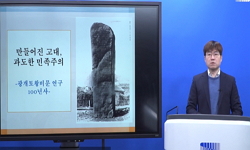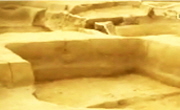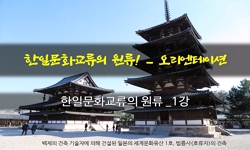도기동산성이 위치한 안성분지 일원은 고대로부터 해상과 육상교통로의 결절지로 삼국의 영역화 과정에서 전략적 요충지 역할을 하였는데 이러한 안성분지의 중심에 도기동산성이 위치한...
http://chineseinput.net/에서 pinyin(병음)방식으로 중국어를 변환할 수 있습니다.
변환된 중국어를 복사하여 사용하시면 됩니다.
- 中文 을 입력하시려면 zhongwen을 입력하시고 space를누르시면됩니다.
- 北京 을 입력하시려면 beijing을 입력하시고 space를 누르시면 됩니다.
https://www.riss.kr/link?id=A103309082
- 저자
- 발행기관
- 학술지명
- 권호사항
-
발행연도
2017
-
작성언어
Korean
-
주제어
안성천 ; 도기동산성 ; 백제 ; 고구려 ; 토성 ; 목책 ; 성벽 ; Anseongcheon ; Dogidong Fortress ; Baekje ; Goguryeo ; Earthen fortress ; Wooden fence ; Rampart
-
등재정보
KCI등재
-
자료형태
학술저널
-
수록면
53-93(41쪽)
-
KCI 피인용횟수
4
- DOI식별코드
- 제공처
-
0
상세조회 -
0
다운로드
부가정보
국문 초록 (Abstract)
도기동산성은 주로 성벽부분을 중심으로 수차례의 발굴조사가 진행되었으며, 발굴조사 결과 토성에서 목책성으로 변모한 것으로 여겨진다. 초축 성벽은 구릉 경사면을 단이 지게 굴토한 후 성토하여 높은 토루를 조성하고 상부에 목책을 설치하였다. 주된 방어벽은 토루로 목책은 여담과 같은 역할을 한 토성으로 판단된다. 축조시기는 후대 성벽 구조물과 내부공간의 주거지 및 저장구덩에서 출토되는 백제토기와 성벽의 AMS 연대 측정 결과 등을 고려할 때 한성 백제기인 4세기 중·후반 무렵을 전후한 시기에 축성되어 5세기 대 까지 운용된 것으로 판단된다.
초축 성벽의 상부를 정지한 후 축조한 목책은 서로 연결된 내·외 이중목책 구조로 바깥 목책에 점토를 두텁게 바른 석축시설을 덧대고 외부에 성토하여 목책을 보강한 구조적 특징을 나타낸다. 이러한 목책구조는 세종 남성골산성과 연천 무등리2보루 등의 성벽구조와 매우 유사한 것으로 고구려 목책성의 구조적 특징을 잘 보여준다. 성벽 구조물에서 출토되는 고구려 토기의 특징 상 5세기 후반에서 6세기 중반 대에 해당하여 475년 고구려의 한성 공함 동시에 곧바로 안성지역까지 진출하여 축조하였음을 알 수 있다.
아울러 산성의 평면구조는 발굴된 성벽의 위치와 진행방향으로 볼 때 내·외성으로 구성된 중성구조이며, 북문과 남문의 문지 두 곳이 있었던 것으로 추정된다. 규모는 내성의 둘레가 약 1.4km 정도이며, 외성을 포함한 전체 둘레는 2km는 족히 되는 거성으로 남한 내 고구려 성곽에서 가장 크며, 백제토성 중에서도 중앙의 몽촌토성과 지방국읍체의 중심으로 비정되는 화성 길성리토성에 버금가는 것으로 산성의 규모와 지정학적 위치상 백제와 고구려의 남방경략과정에서 거점성 기능을 하였을 것으로 여겨진다.
도기동산성이 위치한 안성분지 일원은 고대로부터 해상과 육상교통로의 결절지로 삼국의 영역화 과정에서 전략적 요충지 역할을 하였는데 이러한 안성분지의 중심에 도기동산성이 위치한다.
도기동산성은 주로 성벽부분을 중심으로 수차례의 발굴조사가 진행되었으며, 발굴조사 결과 토성에서 목책성으로 변모한 것으로 여겨진다. 초축 성벽은 구릉 경사면을 단이 지게 굴토한 후 성토하여 높은 토루를 조성하고 상부에 목책을 설치하였다. 주된 방어벽은 토루로 목책은 여담과 같은 역할을 한 토성으로 판단된다. 축조시기는 후대 성벽 구조물과 내부공간의 주거지 및 저장구덩에서 출토되는 백제토기와 성벽의 AMS 연대 측정 결과 등을 고려할 때 한성 백제기인 4세기 중·후반 무렵을 전후한 시기에 축성되어 5세기 대 까지 운용된 것으로 판단된다.
초축 성벽의 상부를 정지한 후 축조한 목책은 서로 연결된 내·외 이중목책 구조로 바깥 목책에 점토를 두텁게 바른 석축시설을 덧대고 외부에 성토하여 목책을 보강한 구조적 특징을 나타낸다. 이러한 목책구조는 세종 남성골산성과 연천 무등리2보루 등의 성벽구조와 매우 유사한 것으로 고구려 목책성의 구조적 특징을 잘 보여준다. 성벽 구조물에서 출토되는 고구려 토기의 특징 상 5세기 후반에서 6세기 중반 대에 해당하여 475년 고구려의 한성 공함 동시에 곧바로 안성지역까지 진출하여 축조하였음을 알 수 있다.
아울러 산성의 평면구조는 발굴된 성벽의 위치와 진행방향으로 볼 때 내·외성으로 구성된 중성구조이며, 북문과 남문의 문지 두 곳이 있었던 것으로 추정된다. 규모는 내성의 둘레가 약 1.4km 정도이며, 외성을 포함한 전체 둘레는 2km는 족히 되는 거성으로 남한 내 고구려 성곽에서 가장 크며, 백제토성 중에서도 중앙의 몽촌토성과 지방국읍체의 중심으로 비정되는 화성 길성리토성에 버금가는 것으로 산성의 규모와 지정학적 위치상 백제와 고구려의 남방경략과정에서 거점성 기능을 하였을 것으로 여겨진다.
다국어 초록 (Multilingual Abstract)
There have been a few excavation survey mainly around the rampart part of Dogidong Fortress, and as a result of the excavation survey, it seems to have a repairing and alteration process to turn it from the earthen fortress to the wooden fence fortress. The first rampart excavated the sloped area of the ridge to have steps and then it builds the high earthen tower to install the wooden fence on the upper part. The main defense wall is the earthwork that the wooden fence seems to be the earthen fortress with the role that is similar to battlement. The construction period has weak direct base data, but when considering the AMS chronological measurement result and others for the Baekje earthenware and rampart excavated in the post rampart structure, residence of internal space and storage pits, it is considered as constructed in the reign of King Geunchogo around middle and later part of the 4th century, the Hanseong Baekje Era and operated it up to the 5th century era. After leveling the upper part of the first Rampart, the constructed wooden fence has the connected internal and external dual wooden fence structure. It has the structural characteristics with reinforced wooden fence by building up the exterior after applying the stone structure facility that is thickly coated on the external wooden fence. Such a wooden fence structure is very similar to the rampart structure of Sejong Namseonggol Fortress and Yeoncheon Mudeungri2 fort that it displays well of structural characteristics of Goguryeo wooden fence fortresses. For the characteristics of the rampart found in the rampart structures, it would be applicable at the time between the later 5th century to the mid-6th century and it is shown to be constructed by advancing up to the Anseong area simultaneously with the Hanseong fall of Goguryeo in 475.
Furthermore, when looking at the location of the excavated rampart and its direction for the plane structure of the fortress, it is in the dual fortress as it is structured with inner and external fortresses and it is assumed to have two gate the North Gate and South Gate.
For its scale, the circumference of the inner fortress is approximately 1.4km and the overall circumference including the external fortress is at least 2km that this is the largest Goguryeo fortress in South Korea. It is comparable to the Mongchon earthen fortress that is in the middle of the Baekje earthen fortresss and the Hwaseong Gilseong-ri earthen fortress as the central part of local town system, and it seems to take on the role of the hub fortress in the process of advancement toward the southern regions for Baekje and Goguryeo considering the scale of the fortress and its geopolitical location.
The Anseong Basin area where Dogidong Fortress is located is the node of maritime and inland transportation passages from the ancient times with the role of strategically critical location in the territory process of the three kingdoms and Dogidong Fo...
The Anseong Basin area where Dogidong Fortress is located is the node of maritime and inland transportation passages from the ancient times with the role of strategically critical location in the territory process of the three kingdoms and Dogidong Fortress is situated in the central part of the Anseong Basin.
There have been a few excavation survey mainly around the rampart part of Dogidong Fortress, and as a result of the excavation survey, it seems to have a repairing and alteration process to turn it from the earthen fortress to the wooden fence fortress. The first rampart excavated the sloped area of the ridge to have steps and then it builds the high earthen tower to install the wooden fence on the upper part. The main defense wall is the earthwork that the wooden fence seems to be the earthen fortress with the role that is similar to battlement. The construction period has weak direct base data, but when considering the AMS chronological measurement result and others for the Baekje earthenware and rampart excavated in the post rampart structure, residence of internal space and storage pits, it is considered as constructed in the reign of King Geunchogo around middle and later part of the 4th century, the Hanseong Baekje Era and operated it up to the 5th century era. After leveling the upper part of the first Rampart, the constructed wooden fence has the connected internal and external dual wooden fence structure. It has the structural characteristics with reinforced wooden fence by building up the exterior after applying the stone structure facility that is thickly coated on the external wooden fence. Such a wooden fence structure is very similar to the rampart structure of Sejong Namseonggol Fortress and Yeoncheon Mudeungri2 fort that it displays well of structural characteristics of Goguryeo wooden fence fortresses. For the characteristics of the rampart found in the rampart structures, it would be applicable at the time between the later 5th century to the mid-6th century and it is shown to be constructed by advancing up to the Anseong area simultaneously with the Hanseong fall of Goguryeo in 475.
Furthermore, when looking at the location of the excavated rampart and its direction for the plane structure of the fortress, it is in the dual fortress as it is structured with inner and external fortresses and it is assumed to have two gate the North Gate and South Gate.
For its scale, the circumference of the inner fortress is approximately 1.4km and the overall circumference including the external fortress is at least 2km that this is the largest Goguryeo fortress in South Korea. It is comparable to the Mongchon earthen fortress that is in the middle of the Baekje earthen fortresss and the Hwaseong Gilseong-ri earthen fortress as the central part of local town system, and it seems to take on the role of the hub fortress in the process of advancement toward the southern regions for Baekje and Goguryeo considering the scale of the fortress and its geopolitical location.
목차 (Table of Contents)
- 국문초록
- Ⅰ. 머리말
- Ⅱ. 산성의 조사현황
- Ⅲ. 산성의 구조
- Ⅳ. 맺음말
- 국문초록
- Ⅰ. 머리말
- Ⅱ. 산성의 조사현황
- Ⅲ. 산성의 구조
- Ⅳ. 맺음말
- 참고문헌
- Abstract
참고문헌 (Reference)
1 권오영, "화성지역 고고학 연구의 현황과 쟁점" 화성시 2016
2 이혁희, "한성백제기 토성의 축조기법과 그 의미" 한국고고학회 (89) : 173-215, 2013
3 중원문화재연구원, "충주 탄금대토성Ⅰ" 2009
4 덕난문화유산연구원, "청주 석화리 산23번지 버섯재배사부지 내 유적 발굴조사 전문가검토회의자료집"
5 박태우, "월평동산성(月坪洞山城) 성벽(城壁) 축조기법(築造技法)과 시기(時期)에 대한 검토(檢討)" 백제문화연구소 (35) : 75-100, 2006
6 서울대학교박물관, "연천 무등리 2보루" 2015
7 경기도박물관, "안성천 Vol.2 문화유적(1)" 2003
8 단국대학교 중앙박물관, "안성시의 역사와 문화유적" 1999
9 기남문화재연구원, "안성 도기동산성 긴급발굴조사 약보고서" 2016
10 기남문화재연구원, "안성 도기동고분군 주변 매장문화재 학술지표조사보고서" 2017
1 권오영, "화성지역 고고학 연구의 현황과 쟁점" 화성시 2016
2 이혁희, "한성백제기 토성의 축조기법과 그 의미" 한국고고학회 (89) : 173-215, 2013
3 중원문화재연구원, "충주 탄금대토성Ⅰ" 2009
4 덕난문화유산연구원, "청주 석화리 산23번지 버섯재배사부지 내 유적 발굴조사 전문가검토회의자료집"
5 박태우, "월평동산성(月坪洞山城) 성벽(城壁) 축조기법(築造技法)과 시기(時期)에 대한 검토(檢討)" 백제문화연구소 (35) : 75-100, 2006
6 서울대학교박물관, "연천 무등리 2보루" 2015
7 경기도박물관, "안성천 Vol.2 문화유적(1)" 2003
8 단국대학교 중앙박물관, "안성시의 역사와 문화유적" 1999
9 기남문화재연구원, "안성 도기동산성 긴급발굴조사 약보고서" 2016
10 기남문화재연구원, "안성 도기동고분군 주변 매장문화재 학술지표조사보고서" 2017
11 세종대학교 박물관, "안성 도기동 산52번지 창고신축부지 내 유적" 2016
12 기남문화재연구, "안성 도기동 산51-5번지 일원 창고부지 내 유적 발굴조사 약식보고서" 2015
13 세종대학교 박물관, "안성 도기동 산51-3번지 건물신축부지 내 유적" 2016
14 누리고고학연구소, "안성 도기동 산18번지 일원 제1종 근린생활시설 조성부지 내 유적 발굴조사 전문가검토회의 자료집"
15 기남문화재연구원, "안성 도기동 산11번지 일원 공장 및 교육연구시설 문화재 정밀발굴조사 전문가 검토회의 자료집"
16 서울문화유산연구원, "안성 도기동 465번지 다세대주택 신축부지 내 유적 정밀발굴조사 전문가검토회의 자료집"
17 겨레문화유산연구원, "안성 도기동 436-1번지 유적" 2016
18 기남문화재연구원, "안성 당왕지구(5블럭) 문화재 발굴조사 2차 학술자문회의 자료"
19 기호문화재연구원, "안성 뉴타운지구 택지개발부지 문화재 지표조사보고서" 2006
20 심광주, "아차산 일대 보루군의 역사적 가치와 보존방안" 한강문화재연구원 2014
21 양시은, "아차산 고구려 보루의 구조 및 성격" 한국대학박물관협회 (79) : 5-28, 2012
22 안성현, "남한지역 토성벽에 잔존하는 석축부에 대한 연구" (사)한국매장문화재협회 (25) : 5-38, 2016
23 최종택, "남한지역 고구려유적 연구현황과 과제" 고구려발해학회 50 : 67-95, 2014
24 양시은, "남한 내 고구려 성곽의 구조와 성격" 고구려발해학회 36 : 97-132, 2010
25 忠北大學校 湖西文化硏究所, "鎭川 大母山城 地表調査 報告書" 1996
26 이혁희, "鎭安臥亭土城의 構造와 性格再檢討" 호서고고학회 (31) : 100-141, 2014
27 한신대학교박물관, "華城 吉城里土城" 2010
28 中部考古學硏究所, "華城 吉城里土城" 2013
29 최종택, "湖西地域 高句麗遺蹟의 調査現況과 歷史的 性格" 백제연구소 (63) : 1-38, 2016
30 中原文化財硏究院, "淸原 南城谷 高句麗遺蹟" 2008
31 忠北大學校博物館, "淸原 南城谷 高句麗遺蹟" 2004
32 中央文化財硏究院, "安城 道基洞遺蹟" 2008
33 안성시, "安城 道基洞 城郭遺蹟 국가지정문화재 지정자료보고서" 2016
34 최종택, "南韓地域 高句麗 土器의 編年 硏究" 한국고대학회 (24) : 283-299, 2006
35 백종오, "中原地域 高句麗 遺蹟 遺物의 檢討" 고구려발해학회 50 : 221-255, 2014
동일학술지(권/호) 다른 논문
-
- 고구려발해학회
- 서승완(Seo Seung-Wan)
- 2017
- KCI등재
-
- 고구려발해학회
- 김은국(Kim eun kuk)
- 2017
- KCI등재
-
- 고구려발해학회
- 구난희(KU, Nan-hee)
- 2017
- KCI등재
-
- 고구려발해학회
- 윤재운(Yun, Jaewoon)
- 2017
- KCI등재
분석정보
인용정보 인용지수 설명보기
학술지 이력
| 연월일 | 이력구분 | 이력상세 | 등재구분 |
|---|---|---|---|
| 2028 | 평가예정 | 재인증평가 신청대상 (재인증) | |
| 2022-01-01 | 평가 | 등재학술지 유지 (재인증) |  |
| 2021-07-02 | 학회명변경 | 영문명 : Institute of KoguryoBalhae -> Association of Koguryo Balhae |  |
| 2019-01-01 | 평가 | 등재학술지 유지 (계속평가) |  |
| 2016-01-01 | 평가 | 등재학술지 유지 (계속평가) |  |
| 2012-01-01 | 평가 | 등재학술지 유지 (등재유지) |  |
| 2009-01-01 | 평가 | 등재학술지 선정 (등재후보2차) |  |
| 2008-02-14 | 학술지명변경 | 한글명 : 고구려연구 -> 고구려발해연구외국어명 : The Koguryo Yonku -> The KoguryoBalhae Yonku |  |
| 2008-02-13 | 학회명변경 | 한글명 : 고구려연구회 -> 고구려발해학회영문명 : Institute of Koguryo Studies -> Institute of KoguryoBalhae |  |
| 2008-01-01 | 평가 | 등재후보 1차 PASS (등재후보1차) |  |
| 2007-01-01 | 평가 | 등재후보학술지 유지 (등재후보1차) |  |
| 2006-01-01 | 평가 | 등재후보 1차 FAIL (등재후보1차) |  |
| 2005-05-30 | 학회명변경 | 영문명 : 미등록 -> Institute of Koguryo Studies |  |
| 2005-01-01 | 평가 | 등재후보학술지 유지 (등재후보1차) |  |
| 2004-01-01 | 평가 | 등재후보학술지 유지 (등재후보1차) |  |
| 2003-01-01 | 평가 | 등재후보학술지 선정 (신규평가) |  |
학술지 인용정보
| 기준연도 | WOS-KCI 통합IF(2년) | KCIF(2년) | KCIF(3년) |
|---|---|---|---|
| 2016 | 0.78 | 0.78 | 0.93 |
| KCIF(4년) | KCIF(5년) | 중심성지수(3년) | 즉시성지수 |
| 0.9 | 0.93 | 2.013 | 0.38 |





 KCI
KCI DBpia
DBpia






